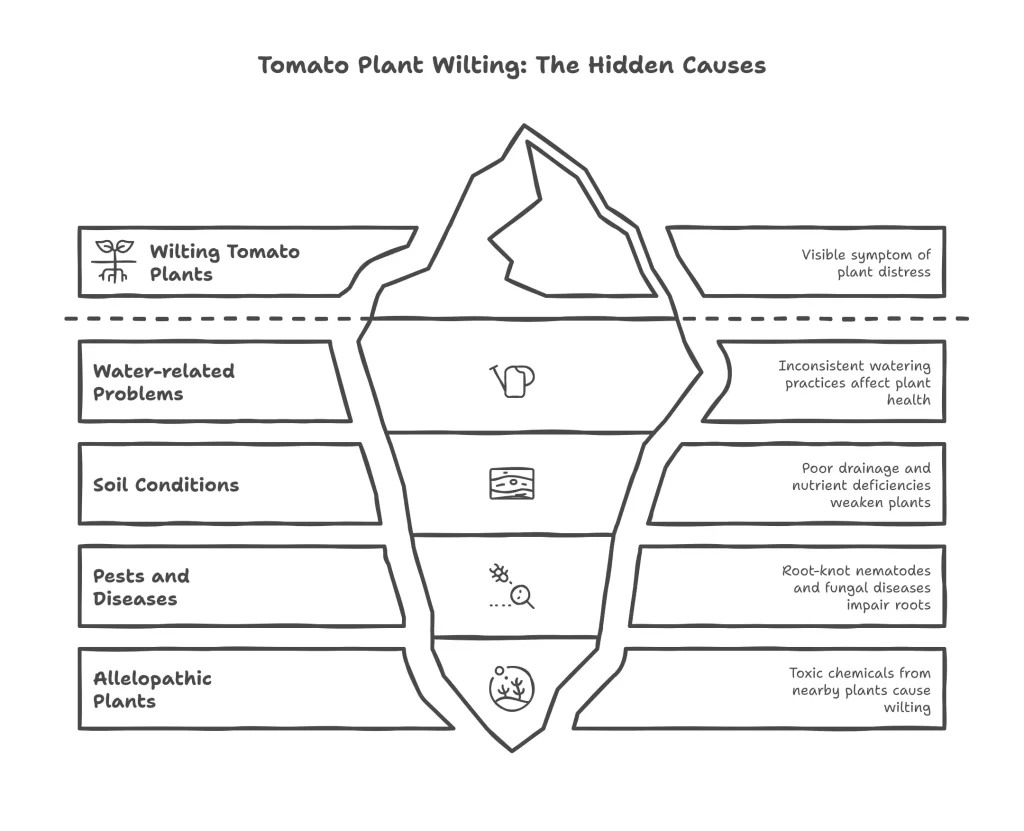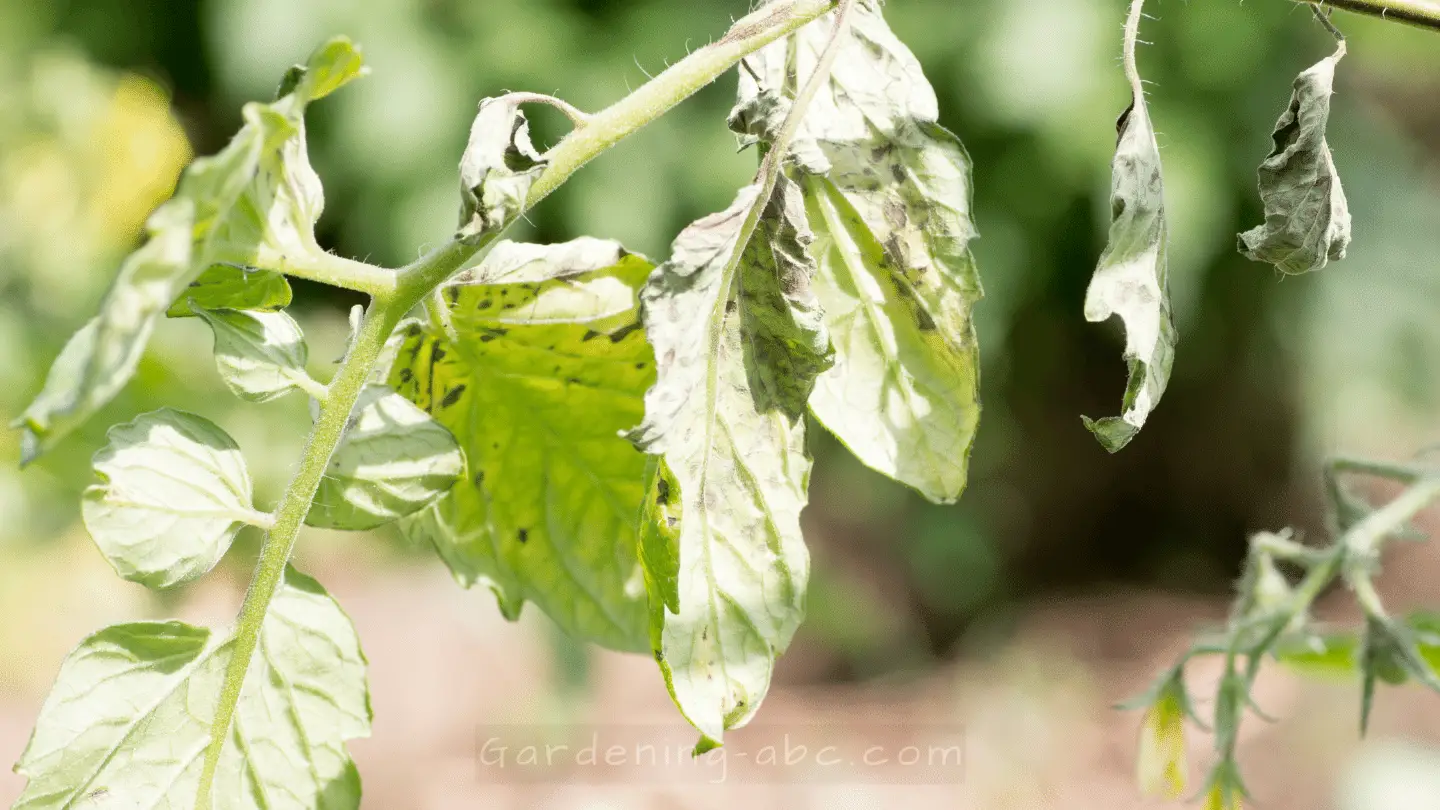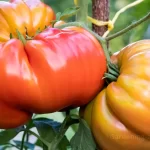We use affiliate links to run our site. When you buy through links on our site, we may earn an affiliate commission, without any added cost to you. Learn more
Have you ever walked into your garden, eager to water your beloved tomato plants, only to find them slumped over, lifeless, and wilted? It’s a heartbreaking sight.
The wilting of tomato plants is a common issue that can be fixed with the right knowledge and action.
In this article, we unravel the mysteries behind wilting tomato plants and provide you with nine reasons for their wilting and, more importantly, how to revive them.
So, grab your gardening gloves and get ready to save your tomatoes from the brink of despair!
- TOOL-FREE ASSEMBLY: The tomatoes cages for garden can…
- PROMOTE CROP GROWTH: The plant support cage allows for…
- HEAVY METAL DUTY TOMATO CAGES: The tomato cages for…
Why Are My Tomato Plants Wilting?


Water-related Problems:
- Lack of Water: Insufficient watering is a primary culprit behind wilting tomato plants. Tomatoes require a consistent supply of water to thrive, particularly during the hot summer months. Inadequate watering leads to water stress and deprives the plants of the necessary hydration for optimal growth.
- Overwatering: Conversely, overwatering can also cause wilting in tomato plants. Excessively moist soil can lead to root rot and prevent the roots from absorbing essential nutrients. This ultimately results in the wilting of the plant, despite the abundance of water available.
Soil Conditions:
- Poor Drainage: Tomato plants prefer well-drained soil that allows water to flow through easily. If your soil has inadequate drainage, excess water can accumulate around the roots, leading to root suffocation and eventual wilting.
- Nutrient Deficiencies: Nutrient deficiencies, particularly in vital elements such as nitrogen, phosphorus, and potassium, can contribute to tomato plant wilting. These nutrients play a crucial role in supporting overall plant health and vigor. A lack of nutrients can weaken the plant, making it more susceptible to wilting.
Currently Trending:
Pests and Diseases:
- Root-knot Nematodes: These microscopic worms are a common pest affecting tomato plants. They invade the roots, causing them to become swollen and impaired in their ability to uptake water and nutrients. Infected plants often display wilting symptoms, yellowing leaves, and stunted growth.
- Fusarium Wilt and Verticillium Wilt: These fungal diseases are caused by soil-borne pathogens and can lead to wilting in tomato plants. The fungi invade the plant’s vascular system, obstructing water and nutrient flow. Plants affected by these diseases exhibit wilting that starts from the lower leaves and progresses upward.
- Planting near allelopathic plants: Planting tomatoes near allelopathic plants like black walnut trees, butternut trees, sunflowers, or tree of heaven can also result in wilting.
These trees release toxic chemicals into the soil. If they are planted too close together, the chemical released from these plants leaches into the soil and gets taken up by the tomato plant through the roots. It will slowly kill the plant, causing a wilting appearance.
How to Prevent Tomato Plant Wilting?
There are basically 3 ways you can prevent tomato wilting.
- Better watering practice.
- Managing your soil.
- By controlling pests and diseases.


Watering Practices:
- Consistent Watering: To prevent wilting due to water stress, it is crucial to maintain consistent watering practices. Water deeply but infrequently, ensuring the soil is moist but not waterlogged. A good rule of thumb is to water tomato plants when the top inch of the soil feels dry.
- Mulching: Applying a layer of organic mulch around the base of tomato plants helps retain soil moisture, regulate temperature, and suppress weed growth. Mulch also acts as a protective barrier, reducing water evaporation and maintaining optimal soil conditions.
Soil Management:
- Improving Drainage: If your soil has poor drainage, consider amending it with organic matter such as compost or well-rotted manure. These additions improve soil structure and facilitate water movement, reducing the risk of waterlogged roots and subsequent wilting.
- Fertilization: Regularly fertilize your tomato plants with a balanced fertilizer or organic alternatives. This ensures they receive an adequate supply of essential nutrients, boosting their resilience and reducing the likelihood of wilting due to nutrient deficiencies.
Pest and Disease Control:
- Crop Rotation: Practicing crop rotation can help minimize the risk of nematode infestations and soil-borne diseases. Rotate your tomato plants with unrelated crops, such as legumes or brassicas, to disrupt the life cycles of pests and pathogens.
- Proper Hygiene: Practice good garden hygiene by removing and disposing of infected plants or plant debris. This reduces the chances of disease spread and reinfection in subsequent seasons.
- Use Disease-Resistant Varieties: When selecting tomato varieties, opt for those that are bred for resistance against common diseases such as Fusarium wilt and Verticillium wilt. These resistant varieties offer better protection against wilting and ensure a higher chance of successful harvests.
- Choose the right kind of companion plants: Not all plants work great with tomatoes, but here is a list of plants considered the best companion plants for tomatoes. Grow them near your tomato plants and avoid plants like black walnut trees, butternut trees, sunflowers, or tree of heaven.
Frequently Asked Questions(FAQs):
How can I determine if my tomato plants are underwatered?
Underwatered tomato plants will wilt in the heat of the day and then revive in the cooler nighttime temperatures, only to wilt again the next day. The leaves will also look and feel thinner than normal. To check if your plants need water, stick your finger into the soil at the base of the plant. If the soil is dry 2 inches below the surface, you need to water your plants.
What should I do if my tomato plants are underwatered?
The simplest solution is to water your plants thoroughly and regularly. Tomatoes require 1 to 2 inches of water per week to thrive. Water slowly over a longer period of time to help the water seep down deeper in the soil, which encourages plants to develop a deep root system. Always deliver water to the base of the plant and avoid getting the foliage wet.
What are the signs of overwatering in tomato plants?
Overwatering can cause root rot, which limits the plant’s ability to take up water and nutrients. Overwatered tomato plants will wilt even when the soil is moist and may have yellowing leaves or stunted growth. You may also notice puddles of water around your plants or fungus gnats flying around.
How do I fix overwatered tomato plants?
The first step is to limit your watering and give the soil time to completely dry out before watering again. You may also need to improve the drainage of your soil by adding organic matter or perlite. If root rot has set in, you may need to remove the plant from the soil, cut off any sections of the dead root, and replant in well-draining soil.
Can transplanting cause wilting in tomato plants?
Yes, transplanting can cause a condition called transplant shock, which is a result of stress from moving from indoors to outdoors, from warm soil to cold soil, or from damaging the roots in the process of replanting. Signs of transplant shock include wilting and yellowing leaves.
What should I do if my tomato plants experience transplant shock?
The best way to prevent transplant shock is to harden off your tomato plants before moving them outdoors. This means gradually exposing them to outdoor conditions for a few hours a day for a week or two before planting them in their final location. You should also avoid transplanting when it is too hot or too cold and choose a cloudy day or late afternoon. Water your plants well before and after transplanting and add some compost or fertilizer to help them recover.
Can cold temperatures cause wilting in tomato plants?
Yes, cold temperatures can cause wilting in tomato plants because they reduce the plant’s ability to absorb water and nutrients from the soil. Tomato plants are sensitive to frost and will die if exposed to freezing temperatures.
How can I protect my tomato plants from cold temperatures?
The best way to protect your tomato plants from cold temperatures is to cover them with frost cloth, plastic sheeting, or old blankets at night when frost is expected. You can also use cloches, row covers, or cold frames to create a warmer microclimate for your plants. Alternatively, you can grow your tomatoes in containers and move them indoors when it gets too cold.
What is Tomato Spotted Wilt Virus?
Tomato Spotted Wilt Virus (TSWV) is a disease that affects many crops, including tomatoes. It is spread by thrips, which are tiny insects that feed on plant sap. Symptoms of TSWV include wilting, stunted growth, yellowing leaves, brown spots on stems and fruits, and ring-shaped patterns on fruits. There is no cure for TSWV once a plant is infected.
How can I prevent TSWV in my plants?
The best way to prevent TSWV is to control thrips by using insecticidal soap, neem oil, or pyrethrin spray on your plants. You should also remove any weeds or debris that may harbor thrips and avoid planting tomatoes near other susceptible crops like peppers, eggplants, or potatoes. You can also choose resistant varieties of tomatoes that are less likely to get infected by TSWV.
Conclusion:
Tomato plants may wilt for various reasons, including water-related issues, soil conditions, and pest or disease infestations. By implementing the strategies we discussed in the article, you can revive your wilting tomato plants and ensure a bountiful harvest.
If you found this article helpful, we encourage you to share it with fellow gardeners who might be facing similar challenges. Explore more informative articles on our website to enhance your gardening knowledge and master the art of growing delicious tomatoes.
With a bit of care and attention, your tomato plants will thrive, rewarding you with an abundance of delicious fruits all season long. Happy gardening!
Amazon and the Amazon logo are trademarks of Amazon.com, Inc, or its affiliates.


Hi there! My name is Prasenjit and I’m an avid gardener and someone who has grown a passion for growing plants. From my hands-on experience, I have learned what works and what doesn’t. Here I share everything I have learned.






